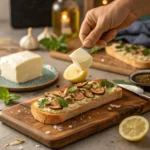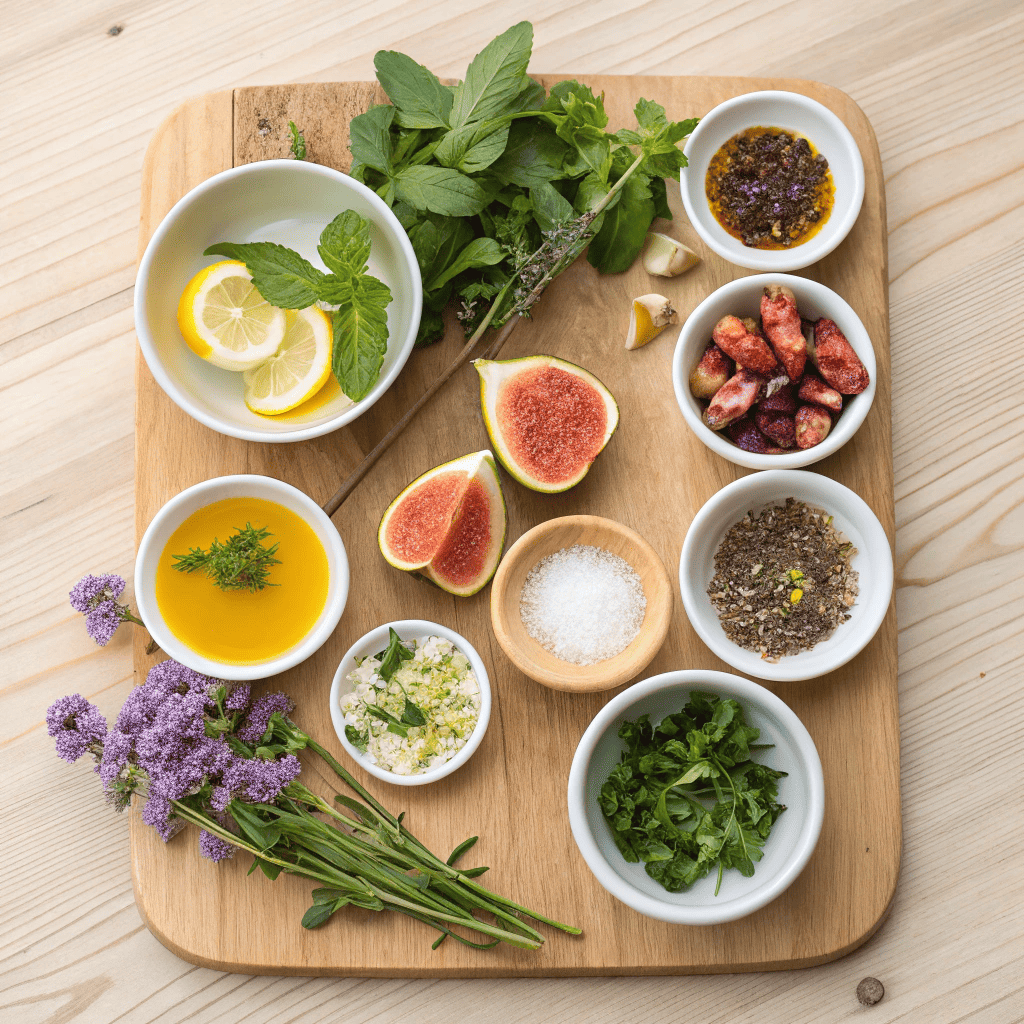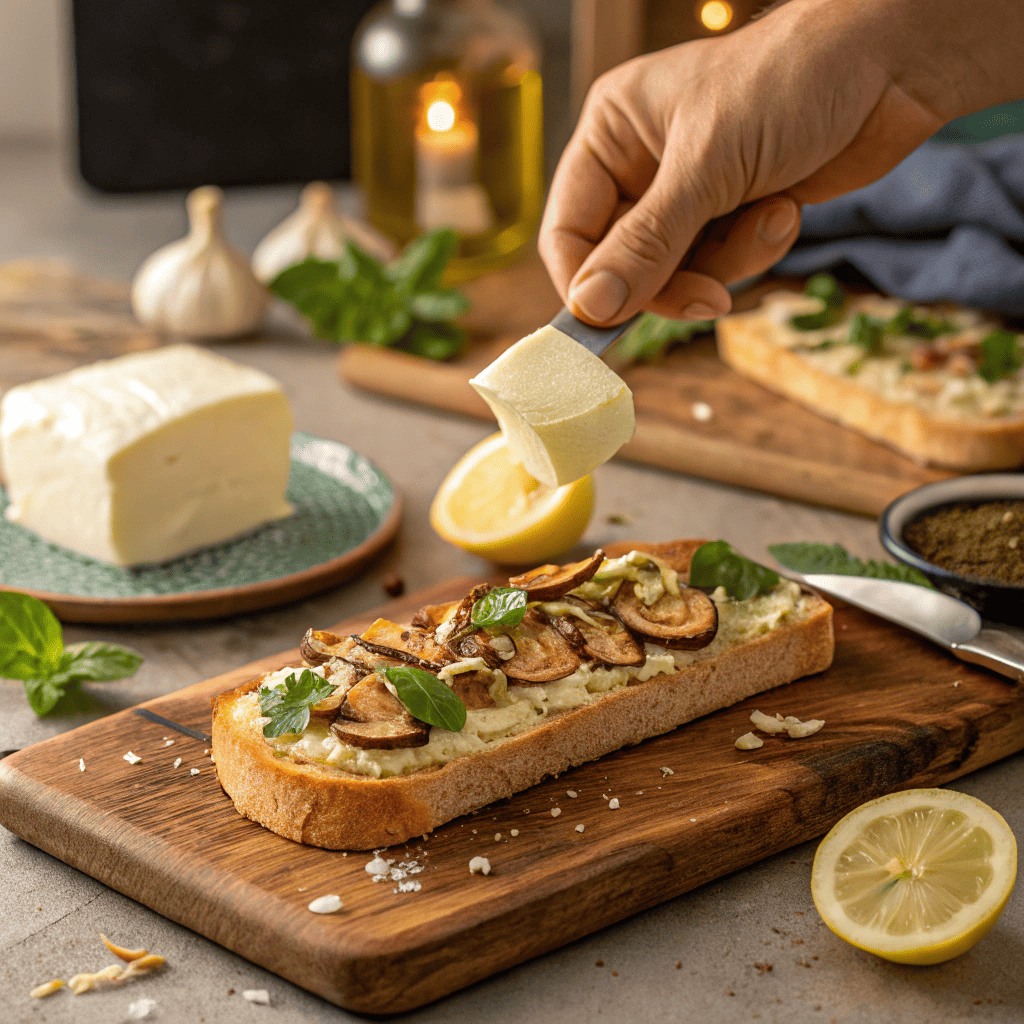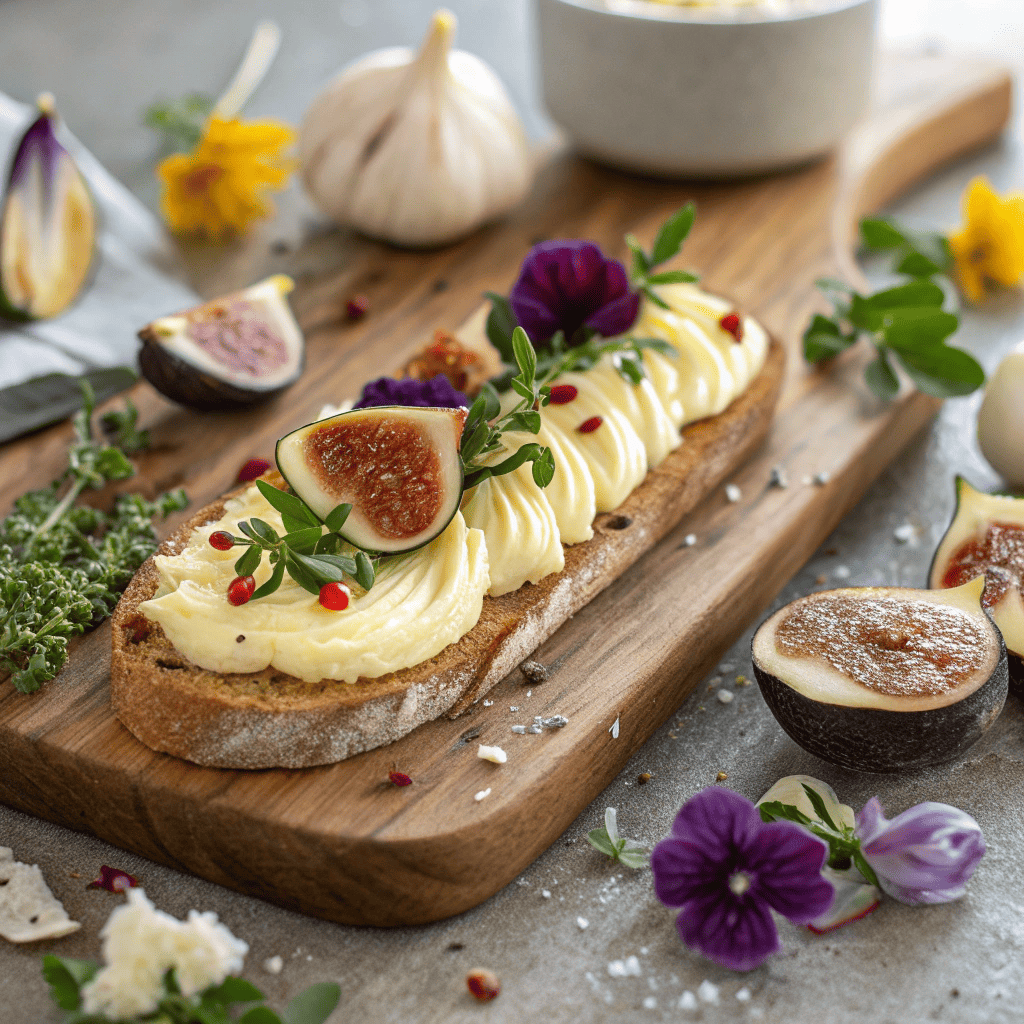How to Make a Butter Board – Justine Doiron’s Viral Party Starter
Butter Board Beginnings: From Viral Trend to Homestead Staple
The first time I saw someone make a butter board, I was halfway through kneading sourdough on a rainy October afternoon. I had flour on my hands, a stew simmering on the stove, and my phone propped up beside a jar of pickled beets. That’s when Justine Doiron’s video popped up—she was gently swirling softened butter across a wooden board and topping it with herbs, salt, citrus zest, even edible flowers. It wasn’t fussy or formal. It was inviting, generous, and completely unexpected. Something about the whole thing felt like home, but also new. I’d made plenty of compound butters before, using garlic from our garden or dill I’d strung to dry on the porch rafters—but I’d never thought to serve butter like this.
Why a Butter Board Belongs on Every Table
Since then, the butter board has become a go-to for gatherings at our place—especially in late summer, when the garden’s throwing more herbs and edible blooms than I can keep up with. There’s something so down-to-earth about laying out a board like that and letting everyone dig in with warm slices of crusty bread. It’s casual, sure, but it also feels special, like you’re sharing something handmade and heartfelt. And isn’t that what cooking’s really about? The butter board may have started as a social media moment, but it’s earned its spot on my table for good. I love pairing it alongside rustic appetizers like these charcuterie nachos for a spread that never fails to spark conversation. With the right toppings and a little love, it’s more than trendy—it’s timeless.
Table of Contents

Butter Board Recipe – Justine Doiron’s Viral Party Starter
- Total Time: 10 minutes
- Yield: Serves 6
Description
A rustic, visually stunning butter board recipe with sweet and savory toppings—perfect for gatherings.
Ingredients
-
2 sticks unsalted butter, softened
-
2 teaspoons flaky sea salt
-
Zest of 1 lemon
-
2 tablespoons edible dried flowers
Honey Coriander Combo:
-
1 tablespoon honey
-
1 teaspoon ground coriander
-
1/8 teaspoon ground cardamom
-
1 sprig fresh basil
-
1/4 cup fresh mint (half leaves, half chiffonade)
Cilantro + Chilies Combo:
-
1/4 cup fresh cilantro, chopped
-
1/4 cup fresh parsley, chopped
-
1/8 small red onion, thinly sliced
-
2 tablespoons chili d’arbol oil
Roasted Garlic + Rosemary Combo:
-
1/2 cup roasted garlic cloves
-
3 rosemary sprigs, toasted
-
Fresh cracked black pepper
Figs + Mint Combo:
-
5 large fresh figs, chopped
-
1 tablespoon honey or agave syrup
-
1/2 teaspoon cinnamon
-
1/4 cup mint leaves (half chiffonade, half whole)
Instructions
-
Let butter soften until spreadable.
-
Spread butter on serving board in swirls.
-
Sprinkle with flaky salt and lemon zest.
-
Add selected toppings evenly across butter.
-
Garnish with edible flowers and herbs.
-
Serve with warm, crusty bread.
Notes
-
Feel free to mix and match toppings based on season or theme.
-
You can prep the board ahead—refrigerate for up to 2 hours before serving.
- Prep Time: 10 minutes
- Cook Time: 0 minutes
- Category: Appetizer
- Method: No-cook
- Cuisine: American / Homestead
Keywords: butter board, party appetizer, compound butter, flavored butter, charcuterie board alternative
Butter Board Basics – The Essentials
The Guidelines You’ll Want to Follow
A butter board isn’t just about smearing butter on a slab and hoping for the best—it’s about balance, texture, and inviting presentation. Start with good butter. I mean really good butter—European-style if you can, with high fat content and no added salt. Let it soften until it spreads like peanut butter, not soup. That texture is key. I like to use a wooden board, but a slate or ceramic tray works just as well—just make sure it’s food-safe and easy to wipe clean.
Next comes the layout. Use the back of a spoon to swirl the butter across the board in even strokes, about a quarter inch thick. This gives it that signature visual flair. From there, season with flaky sea salt and a touch of citrus zest. These bring contrast and freshness. The final step? Toppings. You don’t need much—just two or three bold choices layered across the butter so each bite is different. A few toasted nuts, maybe some herbs, or even leftover roasted garlic from last night’s venison cowboy butter—if you’ve got it, use it.

The Essential Ingredients I Always Recommend
Over time, I’ve learned that certain ingredients just belong on a butter board. Flaky sea salt is non-negotiable. Its crunch and clean brininess bring the butter to life. Lemon or orange zest adds a fresh twist that cuts through the richness. And edible flowers? Well, they’re not just pretty—they lend a subtle herbaceousness and turn your board into something worth talking about.
Beyond the basics, fresh herbs are your best friend. Parsley, dill, mint, or even thyme—all offer something unique. I like to mix textures, too: try pairing soft fig slices with something crisp like radish or even a bit of onion for a kick. A drizzle of honey or chili oil gives each swipe of bread a little surprise. Think of your butter board as a blank canvas. What you spread, sprinkle, or scatter on top turns it into a story.
Building Flavor on Your Butter Board
Sweet & Bright: Honey Coriander and Figs + Mint
When you want your butter board to lean toward sweet, fragrant, and a little playful, these two topping combos deliver in the best way. Honey coriander is one of my all-time favorites—earthy coriander with warm cardamom and fresh mint layered over softened butter brings a depth that feels fancy but comes together in minutes. Add a few basil leaves for brightness and a swirl of golden honey for that glossy, sticky finish guests can’t resist.
Figs and mint, on the other hand, are for when you want something that feels rustic and slightly indulgent. Chopped fresh figs melt into the butter just enough to leave their syrupy trace, while a sprinkle of cinnamon and a drizzle of honey give it a cozy feel. Mint cuts through all that richness like a breeze on a hot day. I first tried this combo after making a batch of blood tongue sausage and needed something cooling to serve on the side—it turned out to be a crowd-pleasing balance.
Bold & Savory: Roasted Garlic + Rosemary and Cilantro + Chilies
If you’re more into savory boards (and I often am), these next pairings bring the kind of bold flavor that’ll have folks hovering by the platter. Roasted garlic is buttery in its own right—sweet, mellow, and perfect for layering over actual butter. Add rosemary sprigs toasted just enough to make your kitchen smell like a wood-fired oven, and you’ve got something both comforting and striking. Crack a little black pepper over the top and you’re golden.
Then there’s cilantro and chilies. This combo wakes up the whole board with fresh green herbs and the smoky depth of chili d’arbol oil. The heat doesn’t overpower—it builds gently, especially when cut with slivered red onion and bright parsley. It’s the kind of topping that surprises people—in a good way. On a crisp slice of sourdough, with butter soft enough to scoop, it’s proof that a butter board doesn’t have to be dainty to be delicious.

How to Make a Butter Board
What You’ll Need – Equipment and Ingredients
Putting together a butter board doesn’t take fancy tools—just a few kitchen staples and a little intention. You’ll need a solid board or platter to start with. Wood works beautifully, but slate or ceramic adds a clean, modern look. Just make sure it’s food-safe and big enough to hold your butter and toppings without crowding.
Here’s what you’ll want on hand:
- 2 sticks of high-quality unsalted butter, softened
- Flaky sea salt
- Zest from one lemon
- Edible dried flowers (optional, but striking)
- Your choice of toppings (like roasted garlic, fresh mint, figs, or chili oil)
- Crusty bread—sourdough or hearty whole grain is best
Having a small butter knife or spoon helps you swirl the butter in a visually appealing way. For folks who enjoy pairing flavors with meats or rich mains, this board goes beautifully alongside something like wild turkey recipes or a rustic soup.
How to Put It Together (Instructions + Pro Tips)
- Soften the butter fully. Let it sit out until it’s easily spreadable—think peanut butter consistency, not melting.
- Spread the butter in swirls. Use the back of a spoon or spatula to sweep the butter across the board in waves or loops.
- Season simply. Sprinkle with flaky salt and lemon zest. These brighten and balance the richness.
- Add your toppings. Choose one or two combos (from the sweet or savory pairings above). Distribute evenly across the butter.
- Finish with flourishes. A scattering of edible flowers or fresh herbs adds texture and color.
- Serve with bread. Offer slices of crusty bread or baguette on the side, slightly warm if possible.
Pro tip: If prepping ahead, spread the butter and refrigerate the board for up to a few hours. Add fresh toppings just before serving to keep everything vibrant.
Frequently Asked Questions About Butter Boards
What’s the point of a butter board?
A butter board is about more than just serving butter—it’s a way to make the simple act of breaking bread feel like a shared experience. Instead of individual butter pats, guests gather around a communal board, swiping warm bread through layers of seasoned, artistically arranged butter. It’s casual, interactive, and makes appetizers feel a bit more personal.
What do you use a butter board for?
Butter boards are perfect for gatherings, especially when paired with crusty bread, crackers, or seasonal accompaniments. They work well as starters before a main course, or as part of a grazing table. Whether it’s a holiday dinner, book club night, or Sunday brunch, a butter board brings people together—and gives them something to talk about.
Are butter boards healthy?
Butter, by nature, is rich in fat—but that doesn’t mean a butter board can’t be part of a balanced diet. Choosing high-quality unsalted butter and pairing it with wholesome toppings like herbs, citrus zest, figs, or garlic can elevate both taste and nutrition. The key is to enjoy it in moderation and pair it with hearty breads that offer fiber and substance.
What is the purpose of board butter?
Board butter” has two meanings. In woodworking, it refers to a blend of oils and beeswax used to condition wooden cutting boards. In the kitchen, a butter board is a presentation method—layering soft butter on a board and topping it with flavorful garnishes to serve as a shared appetizer. They may sound similar, but they’re used in entirely different ways.
Conclusion
At the heart of the butter board trend is something timeless: sharing good food in a way that feels generous and grounded. Whether you’re swirling herbs into softened butter from your kitchen garden or adding figs and mint from the market, the result is something your guests won’t soon forget. You don’t need fancy gear or culinary training—just real ingredients, a bit of creativity, and a willingness to let folks gather close and break bread together.
So next time you’re hosting, skip the store-bought dips and bring out your own butter board. It’s rustic, it’s beautiful, and best of all—it tastes like something made by hand, with heart.
📌 Follow along or tag me here:
Facebook: Recipes NYC on Facebook
Pinterest: @Recipes_NYC on Pinterest
Medium: https://medium.com/@recipesnyc

